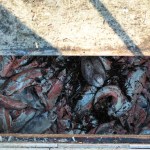Massive Salmon Farm Die-Off Pollutes British Columbia’s Clayoquot Sound
Published by Sea Shepherd Conservation Society

Oil slick and biological debris from dead farmed salmon contaminate Pristine UNESCO Biosphere Reserve
Clayoquot Sound, November 21st, 2019 – Sea Shepherd Conservation Society crew members have been on the water documenting a mass salmon die-off event at salmon farms within Clayoquot Sound, a UNESCO listed World Biosphere Reserve. The video footage reveals the presence of thousands of dead and decomposing fish being loaded onto barges at the aquaculture sites while clean-up crews operate around the clock to clean up the mess. An oily slick has been leaching into the waters of Herbert Inlet and the Moyehai river estuary on the west coast of Vancouver Island, a sign the fish have been decomposing inside the pens for weeks.
“At the rate Cermaq’s staff are working, the die-off is likely in the hundreds of thousands of fish across multiple farm sites, possibly a million fish, it appears the die-off is being downplayed by the company and the magnitude of the emergency has not truly sunken in,” stated Locky Maclean, Director of Marine Operations at Sea Shepherd, concluding “this area has been designated by UNESCO as having universal significance. The Canadian Government has a responsibility to ensure the water flowing through this Sound is clean and healthy, from the open ocean to the inlets and all the way up the rivers. The only long-term solution is for fish farms to be removed from the environment and for the new Fisheries Minister to ensure their removal as soon as possible.”

The pens belong to Cermaq, a company owned by Mitsubishi which produces farmed Atlantic salmon, and are located near Binns Island and Bawden Point within Ahousaht First Nations traditional territories north of Tofino in Clayoquot Sound. Responding to Sea Shepherd’s drone footage, the company has now admitted that over 130,000 fish have died. Cermaq initially put out a statement on November 15th downplaying the massive die-off stating a minor mortality event was due to an algal bloom, after members of local group Clayoquot Action reported multiple trucks carrying dead fish departing the Cermaq facilities at night. The Moyehai River is located within Strathcona Provincial Park and has seen record-low returns of wild salmon in recent years.
Alexandra Morton, an independent biologist, confirmed the presence of Piscine Orthoreovirus, a virus from Norway that appears to cause the jaundice in farmed salmon, stating “neither farmed or wild salmon are surviving this cheap and dirty way of farming. It’s past time to move this industry into tanks.”

Alarmingly high levels of sea-lice have been plaguing fish farm operators on the west coast of Vancouver Island. Internal government emails reveal the sea-lice situation has been out of control, despite Cermaq operating a custom made “Hydro-licer” to de-louse the fish at their sites. Some residents of the area such as business owner Len John, an Ahousaht First Nations member who operates his own whale watching business, Keltsmaht Enterprise, stated “In an attempt to control the lice, Cermaq is killing their own fish using the Hydro-licer, as the salmon cannot survive once they have been pressure-washed through the machine and lost scales, as well as their slimy protective coating.”
This past summer, First Nations members and local citizens took to the streets in Tofino in opposition of 30 years of devastation to the natural environment, since the installation of floating farm pens by the salmon aquaculture corporations. Opposition to salmon farming has become global in recent years as people fight to protect the last wild salmon runs from extinction.












Read the full article at: https://seashepherd.org/2019/11/21/massive-salmon-farm-die-off-pollutes-canadas-clayoquot-sound/



